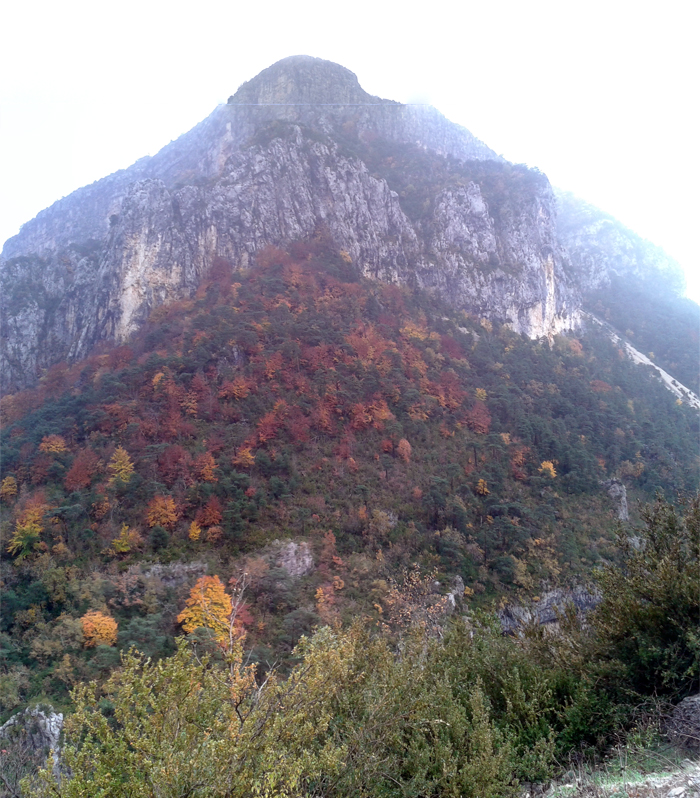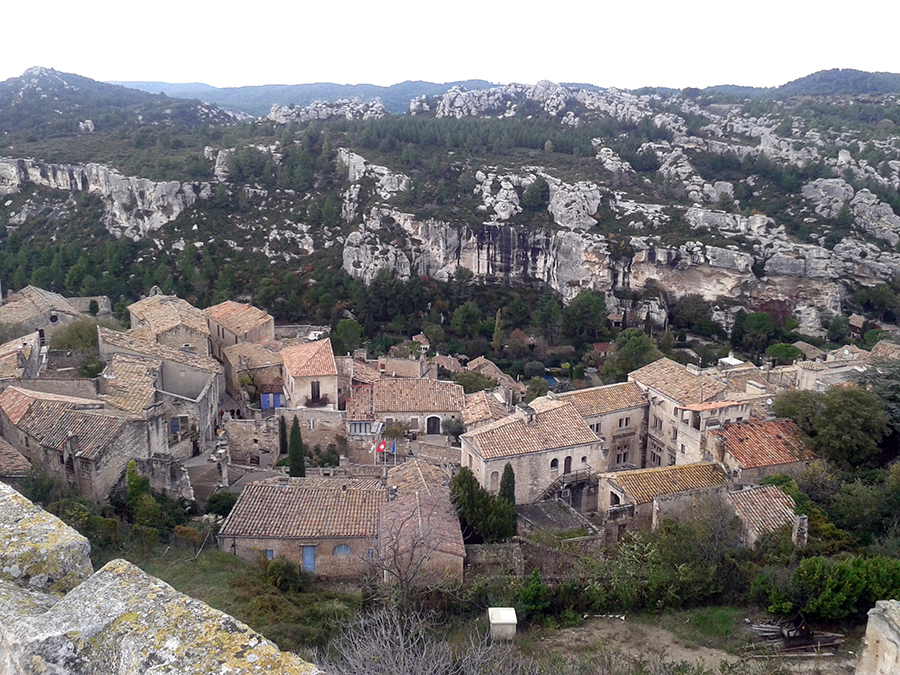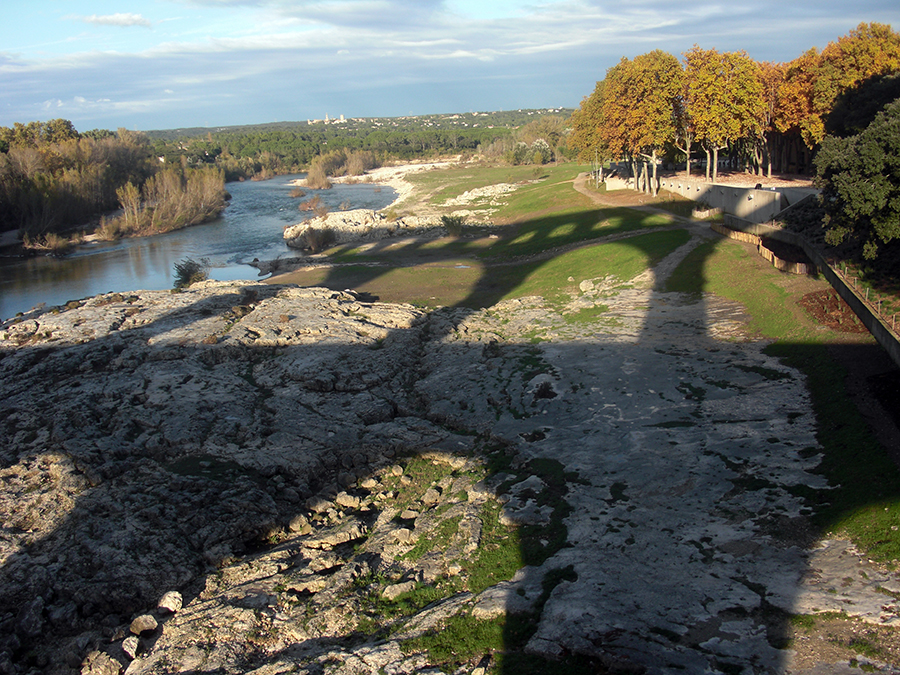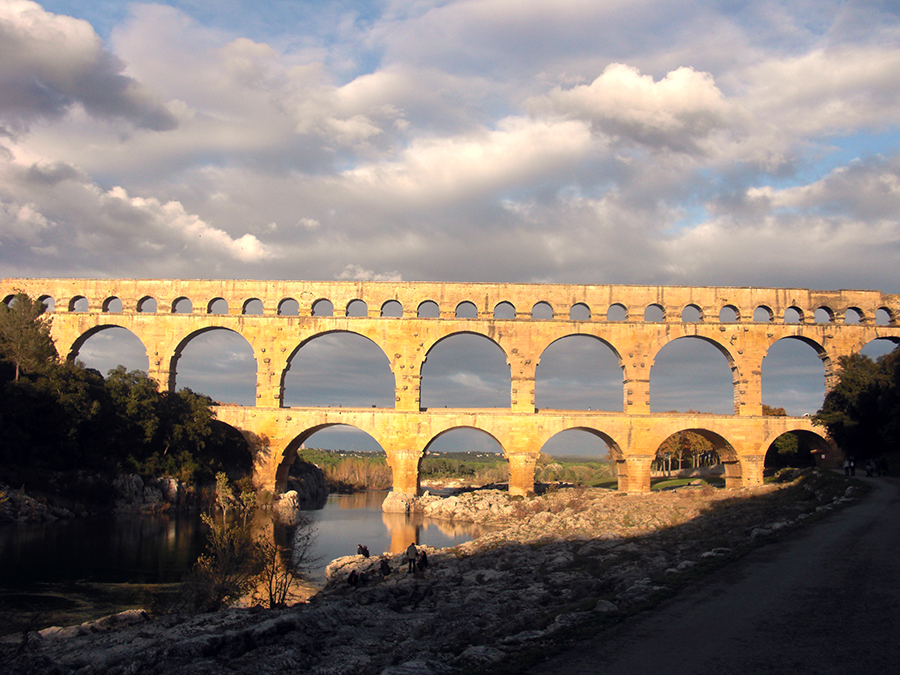In November 2014, Bee and I took advantage of the 11 November holiday to spend a week in Provence.
Part of the reason was to spend some time with my parents who spend a lot of time there; part of the reason was also to get away from the bad weather in Belgium and discover a region of France that we did not know well.
Unfortunately, we hit the worst weather week in Provence for a long time. The weather had been generally bad all over Europe for most of the summer (see also my recent blog entry on the Dolomite in August 2014) but we were particularly unfortunate.
Our first “Road Trip” was to Moustier-Sainte-Marie, the Gorges du Verdon and finally Grasses. We skipped the Lac de Sainte-Croix as the weather just did not allow us to enjoy it.
Moustier is renown for fine pottery and ceramic. There are many workshops, some mostly with ‘tourist’ good, others with very nice ceramic. The town has also maintained its medieval atmosphere and is built on such a steep slope that a lot of streets are still impractical with a car. We walked around town until it started to rain a lot harder and ducked into a local restaurant to escape from getting really wet.
We ate at “Les Santons” (www.lessantons.com) and had a very nice lunch.
After lunch we drove through the top of the Gorges du Verdon, France’s Grand Canyon. There were very nice views, unfortunately not very photogenic, so I decided to experiment. I did not have my big camera, so I took my first panorama using my Samsung Phone. Here is the result.
 It is not bad, and quick and easy, but not quite the same as the results I am used to when I use my big camera and I then assemble the photos using Photoshop. It is clear that the one shot facing the sun was more exposed than the others and the camera was not able to correct entirely for that.
It is not bad, and quick and easy, but not quite the same as the results I am used to when I use my big camera and I then assemble the photos using Photoshop. It is clear that the one shot facing the sun was more exposed than the others and the camera was not able to correct entirely for that.
I also took three photos of the mountain facing us and assembled those in Photoshop and here are the results.
Much better from a blending point of view. So I will have to be careful in the future if I want to use the ‘panorama’ feature of my phone.
From Les Gorges du Verdon, we went on to Grasse, the World Odor Capital. We stopped at the Fragonard Factory where we did a very nice tour of the facilities. Fragonard sells their own perfumes and Eau de Cologne in totally plain containers, as opposed to some of the other companies who sometimes spend more on the bottle than the perfume! Fragonard is also one of the few remaining “Nose Schools” in France. Students are trained to recognize some 300 different odors and the “Experienced” nose can tutor up to 12 students at a time. We saw the ‘school’ room, but class was not in session.
We had spotted a few potentially good restaurants on Trip Advisor, but all of them were closed when we were there. We stopped at La Voute for dinner and had a good meal there.
The next Road Trip took us to Les Baux-de-Provence, a small town in the Alpilles that has become an artist community. Just outside of town there are abandoned stone quarries which are now used for sound and light shows called “Carrières de Lumières” (www.carrieres-lumieres.com). Every year, they have a different show that runs roughly from March to December. The show last show in 2014 was on Klimt and Vienna. Images are projected around the whole quarries while beautiful music plays and it is definitely worth the visit.
We had lunch in Baux and then went to visit the Castle, which as per custom sits at the very top of the village.
The view is quite spectacular, but again, the weather was not really good enough for good photos. I likes better the view of the ancient town from the castle
As it was still early, I thought I would treat Bee to a surprise. All I told her was that there was a rather nice bridge not too far, a bridge that had been there for quite a few years but was now no longer in use.
I was referring to the Pont du Guard, an extremely well preserved Roman aqueduct with three tiers crossing a river. I had been there with my parents about 20 years ago but the local area had definitely been further developed. There is a large visitor center with a museum and a wide path that leads to the Pont itself. The approach is very well done as one does not see right away what the bridge looks like, until it appears suddenly, around a corner, in all its glory. I had to borrow Bee’s pictures for this as I did not take any myself – thanks Bee.
Hard to imagine looking at that that the structure has been there for almost 2000 years!
We walked across the river and Bee noticed how sharp the shadow of the bridge was on the ground behind it. I am very glad now that she took this picture.
We walked to the the back side of the bridge for even more photos. The sun was slowly going down and the light was improving with every minute.
More information on the Pont du Guard is available here: http://www.pontdugard.fr/en
Our last visit, on still another day, was to Aix en Provence. We arrived late, and since it was raining (again) we had an early lunch. Not as early as we wanted as the restaurant where we stopped did not serve before noon and we did not even receive a menu to read or an aperitif before noon even though the staff really was not doing anything particular.
We visited the Cathedral St. Sauveur, which is in the old portion of Aix en Provence. The guidebook indicated that there are two jewels not to be missed: the triptych of the Burning Bush and the cloisters. We walked around the church and noticed that the cloisters were closed and so was the triptych – we could only see the outside of the two doors in each case. No luck, but just in case, we decided to go to the book store and ask the only other person who was in the church at the time.
It turns out that this person is actually one of the official guides who is working as a volunteer with an organisation that protects and preserves the church, the cloisters and the treasures inside. He volunteered to close the shop for a while and take us around the cloisters! It was great as he was full of useful information about the history of the church and the cloisters; since he had lived in Aix all his life, he also had childhood memories of the cloisters many years ago, before the recent restorations.
He could not show us the Burning Bush as they have decided to only open and display the painting during the liturgical events for which it was originally intended. Originally, triptychs were only opened during major christian holidays and in this church in Aix en Provence they have decided to continue that custom. We will have to go back at a time when the painting is open.
We still had a really nice visit, as he showed us other parts of the church that we would not have appreciated as much without his descriptions. Since it did not seem appropriate to give him a “tip”, I offered to make a donation to his association, which was gratefully accepted.
While walking around town, and cruising the internet, we saw indications, very few, of a museum which told of the history of the imprisonment and deportation of Jews and Dissidents during World War II. We decided to go for a visit to the Site Memorial du Champs des Milles (http://www.campdesmilles.org/home2.html) which is just outside of town.
On the site of an old roof tile factory which was family owned and active until the late ’90’s (that is 1990), there is now the only museum on this topic in France in the only remaining internment camp from WWII. In fact the factory was commandeered in 1939 after declaration of the war against Germany as an internment camp for “Foreign Dissidents”, i.e. any German citizen who had fled Nazi Germany and been welcomed, until then, in France. Many famous people came through the camp but were eventually able to ‘escape’ to the United States.
During the Vichy government, it was maintained as a camp for undesirables, but towards latter part of the war, from August 1942 to September 1942, it was used to gather local Jews for transfer to Auschwitz. More than 2000 people were deported. The only reason why that number is not higher is thanks to a concerted effort by the French Resistance and the Cheminots (rail road workers) who made it more and more difficult for the trains to circulate.
Very much worth the visit. One caution though. The guided tour is great, but it takes 4 hours! We were not told that when we signed up and ended up having to leave early as we needed to go home!
On the way back to Belgium, we stopped at one of my favorite places: Chateauneuf-du-Pape where some of the best wine in France is made (my opinion! but I know a lot of people agree with it).
We stayed at the Hotel de la Sommellerie (http://www.la-sommellerie.fr), just outside of town. It is a hotel (only 8 or 10 rooms) with a top restaurant. You do not go there for the night, but for a good meal, and then spend the night so you do not have to drive after drinking all that good wine!
We had a really good relaxing time for a week, even though it did rain a lot, not something you expect when going to Provence.
(663 Page Views)





